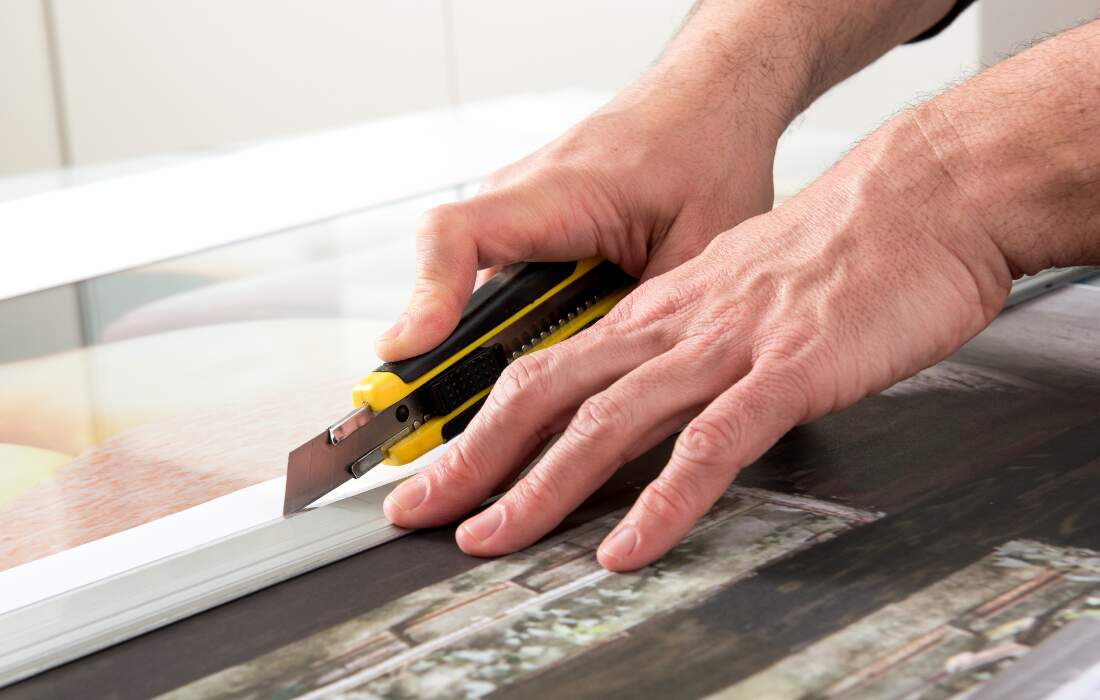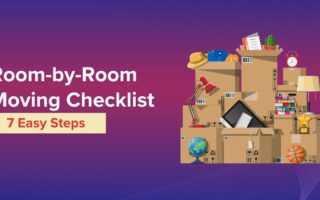How much does moving cost?
Moving involves everything from packing and loading to unpacking and placing your Aunt Maggie’s cherished teapot collection in your new home.

As a local US moving company, we have completed countless moves and, we know no single number satisfies that question. That’s why we always recommend making a moving budget as soon as you know you’re relocating.
A moving budget is more than just a moving checklist.

A complete moving budget should document all the costs associated with your move, factor in room for overages, and prioritize the most important expenses. It should also help reveal some expenses you didn’t initially consider, such as pet care, accommodations, and having enough cash on hand to tip the movers.
To help you create a budget you can stick to, we included a list of common moving supplies and where to find online deals for them in this blog. We even cover the moving costs Americans can claim in 2024 because that may affect your budget, too.
Read on for our five-step guide for creating a moving day budget.
Step 1: Make a Full Home Inventory
Creating a house inventory is critical to your budget’s accuracy and can help you discover things to declutter before packing for a move.
The less stuff you must pack, the more you can save on packing supplies and your movers’ time. Plus, whatever you can sell offsets the total cost of the move. Remember to record sales of items in the moving budget document you’ll make in step two.

Here’s how to make a home inventory for moving
- Create a spreadsheet using a mobile device—easy to use while walking around—or download a free inventory app like Itemtopia. (Old-fashioned paper and pen are fine too.)
- Start in one room and list everything you find there that is coming with you. Repeat this in each room, and don’t forget the garage, shed, basement, and attic.
- Be detailed but concise in your accounting (e.g., “10 t-shirts, 5 jeans”).
- Group similar items together (e.g., kitchenware, clothing, electronics) and color code each category.
- Add notations to precious items, describing their condition and approximate value, and add photos. This step is extra easy with an inventory app.
- Note any heavy or delicate items—pool tables, hot tubs, artwork, pianos, washers and dryers, a car collection, or a wine collection—that may require specialty movers.
- Keep the inventory updated as you declutter or acquire things.
Your completed home inventory will help you get accurate quotes from local movers and budget for moving supplies.
Step 2: Figure out DIY vs Hiring a Moving Company Costs & Hidden Expenses
Now it’s time to set up your moving budget expense sheet and add all the costs associated with packing, moving, and unpacking in your new place.
Start a new spreadsheet and begin listing the items and services we mention below that you will need for your move. List everything that will make your move faster, easier, and safer.
In step four, you will determine what you can and cannot afford.
What to include in a DIY move budget?
Budgeting to move yourself from one home to the next? We get it.
Sometimes, it feels like the only way to do something right is to do it yourself.

For a DIY move, you must source local prices for the following items and list them in your moving budget spreadsheet.
- Truck rental
- Dolly or hand truck rental
- Fuel
- Tolls
- Packing materials (more on these in Step 3)
- Moving Boxes
- Insurance for your belongings
- Temporary storage costs
- Specialty movers (to move what you can’t)
Use your inventory to determine the correct truck size, the insurance coverage you will need, the approximate amount of packing materials you’ll need, and the size requirements for temporary storage.
Cost of hiring a moving company
Hiring professional residential movers? Get quotes from at least three local moving companies and compare their prices and deliverables: how much will you pay, and what will you get in return?
An all-inclusive moving company like Let’s Get Moving streamlines costs by factoring fuel, insurance, distance traveled, the size of the move, number of movers, type of service, tolls, etc., into your quote. Another factor that will impact your moving costs is the day of the month. Save money by inquiring about the cheapest days.

Do you need help packing, unpacking, temporary storage, moving large items, and other value-added moving services?
List the prices for each on your moving budget and label “cost of hiring movers” as a fixed cost. This will help you prioritize your costs in step four.
Finally, look up how much to tip movers so you can add the right amount to your budget sheet and have enough cash on hand by moving day.

Additional Hidden costs
Don’t forget to account for the services, amenities, and necessities you may need for your move. Some of those are:
- Childcare
- Petsitting, pet transportation, or pet-friendly accommodation
- Cost of a hotel or Airbnb
- Meals during travel
- Cleaning supplies
Dig deep to account for all the necessities and creature comforts you may want while moving. Also, read some moving day tips to ensure a smooth transition to your new home.
Are you moving while pregnant?
Consider the unique expenses of being pregnant during a move and list those, too.

Step 3: Make a List of Cheap Moving Supplies
Now that your research muscles are all warmed up, it’s time to find cheap prices for the packing and moving supplies you’ll need.
List everything you need on your moving budget spreadsheet. Next to each item, write the amount you need and the price. If you can get or borrow items for free, note that.
Here are some of the most common moving supplies and suggestions for where to source them.

Note: the products and prices listed here can change at any time.
Moving Boxes
Use your inventory to estimate your box needs: How many boxes do you need? What sizes do you need?
If you can’t get them for free from friends, local stores, or Facebook Marketplace, we spotted some of the cheapest moving boxes at Walmart.com ($1/box) and at Let’s Get Moving.
Wardrobe Boxes
Wardrobe boxes are special boxes for moving clothes on hangers. They save a lot of time when packing and unpacking because no folding and unfolding is necessary.
Of course, convenience comes at a price. For cheap wardrobe boxes, Half Price Boxes USA ($12.54-15.84/each) has the best price.
Packing Tape
Seal boxes completely with a couple of swipes of a tape gun loaded with high-quality tape.
For best results, go over each box’s top twice with a 3-inch overhang. One 55-yard (1980-inch) roll should last up to 38 boxes, size 20×20” or smaller.
Store what you don’t use in its original packaging in a cool, dry (40-50% relative humidity) place, and you won’t have to retape it for a long time.
The cheapest deal on packing tape is at PackagingSupplies.com ($7.45/Case of 6), especially if you get 10% off your first purchase. Add a tape gun to the purchase and pay $16.80 altogether.
Labelling Materials

We found some cheap stickers for labeling moving boxes at Temu.com, where you can get 60 color-coded labels for $1.94 or 250 of them for even less!
Our moving experts always recommend color-coded labels to organize (blue = kitchen, green = powder room, etc.) and identify boxes.
For the cheapest permanent markers, we recommend Amazon.com, where there are incredible daily deals on permanent waterproof markers. Today, we found a pack of 12 that costs $0.58 per pen.

Protective Packaging: Paper, bubbles, peanuts, and more
The moving consultants at Let’s Get Moving recommend using packing paper ($5.97/50 pieces, or $9.99/roll) to wrap delicate items, using foam sheets (buy in bulk at $0.08/sheet) to keep fragile items separated, and adding packing peanuts ($8.77/1.5 cubic feet) to fill the space in boxes so nothing bangs around.
Enkoproducts.com offers two 36-foot rolls of bubble wrap ($19.61/each) for extra-delicate items and to protect the corners of furniture.
Add 1000ft of stretch wrap ($10.99) to your budget to bundle loose items together or secure drawers and doors on furniture. It’s a pro mover’s best friend.
Furniture Protectors
Do you need any of these three common furniture protectors for moving?
- Furniture covers (starting at $14.99/10-piece): protect furniture from scratches, dust, and damage during the move using furniture covers or plastic wrap.
- Moving blankets (starting at $16.22 for 6): protect furniture and large items from scratches and dents during the move.
- Mattress Bags (starting at under $7): protect mattresses from dust, dirt, and damage using mattress bags designed for moving.
You can either buy them from Amazon, Walmart, or any other moving supplied providers.
Storage Bins
Heavy-duty plastic bins offer extra protection for fragile items; most are moisture-resistant or water-proof, perfect for long-term storage.
One budget consideration is using a reusable moving bin service instead of buying cardboard boxes. Reusable storage bins exist throughout North America, but most companies only service local moves.
Extras: Cutters, toolbox, first aid kit
Are there other moving-day tools you might be forgetting? Add what you need to your budget and leave no stone unturned.

- Box cutters and scissors (as low as $1.99): Open boxes and cut packing materials.
- Toolbox ($16.99): Disassemble furniture, remove fixtures, and handle minor repairs on the fly.
- First aid kit ($24.99): Prepare for minor injuries or accidents during moving.
By budgeting for all things, big and small, you can keep your moving costs predictable, manageable, and flexible.
Step 4: Prioritize Expenses and Discover Your Limits
What is the point of making a moving day budget if you don’t have a system for sticking to it? Only start this step if you’ve completed steps one through three.
Start by deciding how much you can afford to spend on your move. Consider your income, savings, and any other financial obligations.
Look at the categories of products and services on your moving budget and write down the maximum amount you’re willing to pay for packing supplies, transportation, and additional services.

Allocate Budget for Unexpected Expenses
From that total, we suggest deducting a buffer amount (e.g., 10-15% of the total budget) so that unexpected expenses or emergencies don’t bust your budget. What you’re left with is what you’ll be using to prioritize your expenses.
Prioritize Expenses
Make a digital copy of your moving budget spreadsheet and start reordering the line items, putting the important necessities (truck, boxes, packing supplies, etc.) at the top and ending with the least important items.

Start deducting costs from your total budget (minus the buffer amount), starting from the top of the list and working your way down. Be prepared to forego some of the less-important items at the bottom of the list.
Be Flexible
Adjust your budget regularly; it’s like a living thing that must be attended to as prices and priorities change leading up to moving day.
If you find ways to increase your budget, you’ll know where to allocate money because it’s already on your list.
Step 5: Find Ways to Save Money
The final step is to find ways to save money on your listed items. When you save money, you can afford more of the things on your list, or maybe you don’t need to spend it at all, and “a penny saved is a penny earned.”

Some ways you can increase your budget are:
- Hold a garage sale or sell items on Facebook Marketplace or other social platforms.
- Don’t move during the busy season (April-October) or at the beginning or end of a month.
- Shop for the best moving quote.
- Ask friends and family to help you during the move or if they have a truck ask them if they can lend it to you for sone time.
- Start a personal crowdfunding campaign to raise additional funds.
If you commit to finding the best deals and making smart purchase choices, your expenses should not exceed the limits of your moving budget.
Conclusion: Moving Budgets are More Than Just Budgets
Moving isn’t cheap, but creating a detailed budget serves multiple purposes.
Making an inventory of your stuff can motivate pre-move decluttering and aid in any property insurance claims.
Then, shopping around for moving services and supplies will reveal hidden deals you may have otherwise missed. It may even change your mind about hiring a local moving company to help.
Finally, your research can reveal some commonly overlooked costs so you can plan for them. Nothing is blindsiding you on move day!
Ultimately, you can make your pre-moving budget as detailed or minimalist as you like; just make sure to revisit it often and update it regularly for optimal accuracy.
FAQs
How much does a local move cost?
The cost of a local move is based on the size of the property, the number of movers, the size of trucks, the distance from point A to point B, the time it takes to complete the job, insurance, fuel, etc.
Our experience and research tell us that movers in the US are hired hourly, and the hourly rate can vary. For example, the moving cost in Atlanta starts at $109 whereas the average moving cost in Houston is $150 per hour.
How do I financially prepare for a move?
Financial preparation for a move starts by researching your area’s exact costs. For instance, the cost of moving in Miami isn’t the same as the cost of hiring movers in Pompano Beach, even if they’re both in Florida.
You can’t prepare financially for a move without knowing what costs you’re up against. Once you know how much you need to save for moving costs, you can prepare further by increasing your available funds (selling things, working side gigs) or cutting costs.
What are the best ways to keep my moving costs down?
Go with the do-it-yourself approach to save money but if the move is complex then you should hire a moving company. To keep moving costs down, never settle for a single moving quote. Shop for the best deals in local moving companies and always ask which days of the month are the cheapest to move.
When buying moving supplies, find deals online at the usual sites (Amazon, Walmart, eBay, etc.), shop at online auctions, and look for online marketplaces and community forums where you can find moving equipment very cheap or even free.
Can I claim moving expenses in America?
Americans can’t claim moving expenses on 2024 taxes except for some military personnel. The 2017 Tax Cuts and Jobs Act included an amendment to rules that allowed citizens to claim some moving expenses if their move was work-related and met certain criteria.



